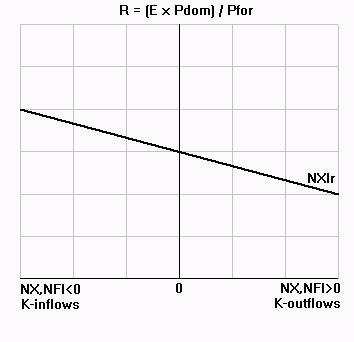D.
Macroeconomic shocks and policies
2. Fixed exchange rates
Key results
(1) Independent monetary policy
does not work
| Example: Expansionary MP
Step 1: Increase supply of money
Step 2: Defend ER
To maintain targeted ER, Fed must
sell FX and buy back $ --> offsetting contractionary MP
General property of fixed ERs: With
fixed ERs and mobile assets, monetary policy does not work. Intuition: MP can't serve 2 masters. When
committed to defending ERs, can't be used to influence output at the same time. |
 |
1979: Fed made a big deal about pegging the
money supply instead of interest rates. That option was available only because
the US was under floating ERs. With fixed ERs, Fed cannot choose its policy
Not necessarily bad news: LDCs may lack
confidence that CBs will be responsible or CBs may be subject to too much
political pressure: Use fixed ERs. Keeps CB disciplined. Maintains stability and confidence. Avoids capital flight.
| (Obstfeld and Taylor,
1998, JEP, 14): The inconsistent trinity or open economy trilemma: a country can choose only two of
the following three options: |
| |
fixed exchange rates |
|
| |
|
|
| autonomous monetary policy |
|
capital mobility |
(2) Fixed ERs enhances the
effectiveness of fiscal policy
Step 1: Increase
G
Step 2: Defend ER with expansionary MP
Result: FP gets reinforced by automatically accommodating MP.
hG g matching
hY instead of
iNX
Long run: Step 3: Inflation raises R.
hG g matching
iNX |
 |
Overall: fixed ERs
with capital mobility make FP more powerful but MP useless.
(3) The long-run effects of policies are the
same regardless of the ER arrangement
Ex: expansionary policies
| |
Floating ERs |
Fixed ERs |
| Monetary policy |
offset by
inflation |
impossible
while
defending the peg |
| Fiscal policy |
offset by
currency
appreciation |
offset by
inflation |
|
|
E Pdom |
|
R =
|
---------- |
|
|
Pfor |
|
| with either
floating or fixed ERs, expansionary FP --> real appreciation |
E. Applications and current issues
1. Dutch disease at the macro level
Recall Dutch
disease at the micro level: the natural resource curse: discovery and
development of a booming tradable sector puts upward pressure on wages,
resulting in a cost squeeze and contraction of traditional exports, such as
manufactures (natural gas versus wooden shoes in the Netherlands)
At the macro level: Dutch
disease can arise from a surge of capital inflows
It's an external shock
Examples:
UK (1970s): Discovery of
North Sea oil --> savers
want to acquire British Petroleum stock
Philippines (2000s):
Surge of remittances
from emigrant labor
NFI shifts left
--> +R --> -NX --> -Y |
 |
2. Responding to external shocks
Example1: the 1992 European financial crisis
At the start of the 1990s, several members
of the European Union, including Germany, France, and the United Kingdom
maintained fixed exchange rates with each other as part of the
European Monetary System (EMS).
In 1992, due in part to the costs of German reunification,
interest rates in Germany rose.
1992: i-rates increased in Germany
an external shock to other EMS members
France: stayed in the EMS and defended the franc ER
(=> contMP)
result: +r --> -I --> -Y
UK: left
the EMS and let the pound fall
result: -R --> +NX --> +Y
|
 |
| |
|
|
Unemployment rates |
1992 |
1996 |
|
France |
10.4% |
12.5% |
|
United Kingdom |
10.1% |
8.2% |
